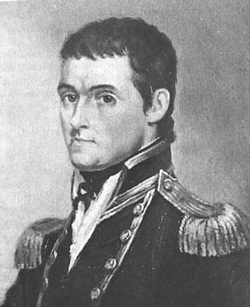16 March 1774 – 19 July 1814

Flinders's first trip to Australia was in 1795 aboard the HMS Reliance. He was recognized early on as a fine navigator and cartographer. Flinders went on two expeditions aboard the boats Tom Thumb. The first went to Botany Bay and the Georges River, and the second to Lake Illawarra.
In 1798 Flinders was given command of the Norfolk and circumnavigated Van Diemen's Land through what would later be named the Bass Strait. On July 17 1799 Flinders arrived in Moreton Bay, once again sailing the Norfolk.
In January 1801 Flinders was given command of the Investigator and promoted to captain. On this voyage, Flinders was issued a French passport because his expedition was scientific in nature.
Flinders reached Cape Leeuwin on December 6, 1801 and surveyed along the southern coast of the Australian mainland. Flinders encountered a French explorer, Nicolas Baudin, with whom he exchanged information. He later named the location of their meeting Encounter Bay. He explored Port Phillip as well. On the return trip to Sydney, Flinders found that his ship was leaking badly. When he finally arrived in Sydney June 9, 1803, the Investigator was condemned.
On his return to England, the ship Flinders was taking wrecked on the Great Barrier Reef. Taking control of another vessel, Flinders attempted to put in at a French-controlled port, where he was arrested under the governor's suspicions. He was held prisoner from the time he put in to port in 1803 until seven years later in 1710.
Flinders died the day after his book, "A Voyage to Terra Australis" and atlas "Atlas to Flinders' Voyage to Terra Australis" was published.
In 1798 Flinders was given command of the Norfolk and circumnavigated Van Diemen's Land through what would later be named the Bass Strait. On July 17 1799 Flinders arrived in Moreton Bay, once again sailing the Norfolk.
In January 1801 Flinders was given command of the Investigator and promoted to captain. On this voyage, Flinders was issued a French passport because his expedition was scientific in nature.
Flinders reached Cape Leeuwin on December 6, 1801 and surveyed along the southern coast of the Australian mainland. Flinders encountered a French explorer, Nicolas Baudin, with whom he exchanged information. He later named the location of their meeting Encounter Bay. He explored Port Phillip as well. On the return trip to Sydney, Flinders found that his ship was leaking badly. When he finally arrived in Sydney June 9, 1803, the Investigator was condemned.
On his return to England, the ship Flinders was taking wrecked on the Great Barrier Reef. Taking control of another vessel, Flinders attempted to put in at a French-controlled port, where he was arrested under the governor's suspicions. He was held prisoner from the time he put in to port in 1803 until seven years later in 1710.
Flinders died the day after his book, "A Voyage to Terra Australis" and atlas "Atlas to Flinders' Voyage to Terra Australis" was published.
